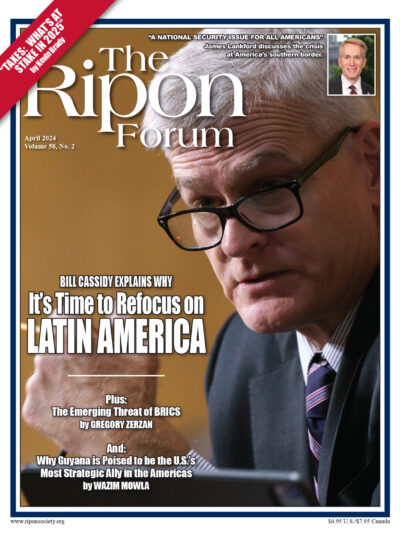
After four years of President Donald Trump’s slash-and-burn trade policies, the bar for the incoming Biden Administration could hardly have been lower. Trump’s “America First” bravado was an ungainly amalgam of tax hikes (against foes and friends alike), bilateral power plays, and a retreat from international trade cooperation (Trump spurned the mega-regional Trans-Pacific Partnership, TPP, and paralyzed the World Trade Organization, WTO). Trump’s trade policies ruffled the feathers of many of America’s closest trade partners. They were also economically ineffective, failing to benefit even those sectors and locations that his tariffs were to supposed to protect. Notably, the Trump tariffs did not change China’s behavior one bit.
It came as no small surprise when Joe Biden, despite calling Trump’s trade actions “disastrous” and “reckless,” not only did not repudiate those policies, but actually amplified them. Whereas, compared to Trump, Biden’s version of economic nationalism is more carrots than sticks (commentators have called it “polite protectionism” or “pragmatic unilateralism”), it is no less fervent.
It came as no small surprise when Joe Biden, despite calling Trump’s trade actions “disastrous” and “reckless,” not only did not repudiate those policies, but actually amplified them.
In a barely noticed but tremendously consequential speech in July 2023, National Security Advisor Jake Sullivan laid out the most coherent version of the Biden Administration’s economic ideology. Sullivan blamed hyper-globalization, trade liberalization, unfettered deregulation, and naïve beliefs in market efficiency for the most pressing challenges currently facing the United States – a hollowed out industrial manufacturing base, dramatic economic inequality, the rise of China, and the climate crisis. Drawing a sharp contrast to the “Washington consensus” – the 1990’s-era policy package championed by the U.S. Treasury, the IMF, and the World Bank that, to many, is synonymous with deregulation and free trade – Sullivan declared that the Biden Administration stood for a “new Washington consensus.” This novel paradigm is aimed at achieving supply chain resilience, more equitable growth that benefits American workers, rapid decarbonization, and a containment of China’s military and economic might. While few Americans would disagree that these are worthy goals, their implementation as proposed by Sullivan – which includes (1) a “modern American industrial strategy,” (2) selective partnerships with economic allies, and (3) various policies aimed at curbing the ascent of China – warrants scrutiny.
Let us start with Biden’s industrial policy. That strategy consists of a mix of muscular government interventions through direct subsidies and tax credits — under the CHIPS Act and the Inflation Reduction Act (IRA) — directed at industries deemed especially critical or strategic, mainly semiconductors and green technologies; “Buy America” provisions for government procurement; favorable loan terms; and protectionist policies, including continuation of many of the Trump-era tariffs, domestic content requirements, and trade defense measures.
While industrial policy, done right, can be useful, all indications are that Biden’s version is poised to cause significant domestic and international damage. This is not the place to offer a fulsome critique of the sizable risks to the domestic economy brought about by Biden’s industrial policy package. Suffice it to say that it is costly (experts expect IRA subsidies to amount to $1.2 trillion over the next decade – three times the initial forecast), which in and of itself is not fatal if the returns are right. However, they may not be: Biden’s policy package is harmful to non-subsidized firms and consumers, and is unlikely to create jobs (it merely shifts them from exporting to protected industries), let alone manufacturing jobs in middle America. It is furthermore unlikely to boost overall competitiveness beyond the initial spending bump.
Moreover, Biden’s industrial policy also has negative international repercussions. First, many implementing actions are in apparent violation of the very trade principles that the United States once held dear. Second, since industrial policy is essentially self-dealing designed to draw investment, production, and raw materials away from other countries, this zero-sum logic will almost definitely provoke an international backlash. Powerful countries will retaliate and/or emulate. Emulating discriminatory U.S. industrial policies can easily trigger lose-lose subsidy wars that, in addition to the monetary costs, tend to stifle innovation and technological diffusion, a particular concern for the desired green energy transition. Poorer countries that cannot afford costly subsidy programs will see export markets and inward investment shrinking, and thus less developmental progress. This breeds mistrust and resentment against the United States and over the short or long haul will draw them towards other trade alliances.
Whereas, compared to Trump, Biden’s version of economic nationalism is more carrots than sticks (commentators have called it “polite protectionism” or “pragmatic unilateralism”), it is no less fervent.
Turning to Biden’s strategy for cooperating with trade partners, consider what this strategy does not include: It neither entails aspirations to pursue traditional trade agreements (such as rejoining the TPP), nor a revitalization of the multilateral trading order (for example, Biden has continued Trump’s blockage of WTO dispute settlement). Instead, the Biden Administration has championed sectoral partnerships and so-called “frameworks” (such as the Indo-Pacific Economic Framework for Prosperity, IPEF). Common to these ventures is Biden’s unwillingness to offer foreign countries additional access to the U.S. market. Rather, the Administration seeks to extract from partners non-binding commitments on environmental or labor standards or to sign off on mutual recognition of existing procedures or standards. All this is weak tea, because in refusing to give something to get something, the United States provides no incentive for partners to cooperate in a meaningful way. Predictably, the last IPEF summit in November of 2023 collapsed, in no small part because developing countries were unwilling to give up comparative advantages (cheaper labor and laxer environmental rules) for nothing in return. Future agreements that the United States may get signed under the current mindset risk being purely transactional bargains that can be violated or revoked at any time. How such “trade” deals are supposed to benefit U.S. workers, make supply chains more resilient, or result in decarbonization is anyone’s guess.
Finally, on Biden’s objective of slowing down China’s economic and military ascent, it has been argued that China pursues aggressive economic policies and has flouted many international trade rules, in letter or in spirit. Yet the United States cannot take on China on its own without risking major economic blowback. To pursue Biden’s China strategy effectively, the United States needs to deepen relations with key allies to marshal a united front against Chinese abuse of the international trading system. The United States and G7 partners have made some progress in coordinating export controls of military and dual-use goods, punishing forced labor, and going after China’s aggressive export behavior, but more concerted efforts are needed.
At its core, the “new Washington consensus” of the Biden Administration is a challenge of five decades of economic orthodoxy and a rejection of the rules-based international economic order for which the United States fought so hard. It espouses a zero-sum logic where one country’s gain is the other’s loss, and where cooperation is ad hoc and transactional – if and when it suits U.S. interests. Given that stance, what is the incentive for third countries to cooperate with the United States? Which country is inclined to wholeheartedly consent to this “new consensus?”
At its core, the “new Washington consensus” of the Biden Administration is a challenge of five decades of economic orthodoxy and a rejection of the rules-based international economic order for which the United States fought so hard.
Granted, international trade currently has a bad rep with U.S. audiences stretching from the nationalist right to the progressive left. Yet, instead of the pendulum swinging wildly towards neo-protectionism, future administrations may consider improving on the existing rules-based order – call it Washington consensus 2.0. What could such an updated WC2.0 look like?
Domestically, it would capture the gains of liberalized trade, while offering effective protection from the downsides of globalization. The focus thereby would be on workers, not jobs – by promoting job creation in distressed areas and improving transition assistance for those having lost their jobs to international competition. The Nordic countries and New Zealand teach us that an economy can be open and egalitarian at the same time. Next, WC2.0 would foster (WTO-compliant!) investment in infrastructure, R&D, education, and talent attraction, rather than betting on hand-picked industries. It would focus on technology adoption, not technology production: adoption and diffusion of the best available technologies (even if imported) is more likely to create long-lasting economic benefits and larger innovative breakthroughs than a government trying to pick winning technologies.
Internationally, WC2.0 would have the United States pursue more and deeper trade agreements with large memberships, such as TPP, since it is better to coordinate, not compete, with allies on public investments in high tech or decarbonization. Such trade agreements would adopt common technical standards on a global scale. They would also provide a veritable counterbalance to China’s expansionism. Finally, under WC2.0 the United States would immediately revive WTO dispute settlement and reengage in (an, admittedly, overdue) WTO reform that squarely takes on rule flaunting by non-market economies. And if China, India, or any other WTO Member were to block meaningful WTO reform, the United States should rally the largest possible coalition of the willing.
International trade is not going anywhere. The question is how and to what degree the United States will participate. Historically, expanding trade has delivered tremendous value to the U.S. economy. WC2.0 could help capture the gains of liberalized trade and make up for domestic losses. It could reacquaint Americans with an appreciation that trade rewards innovation, efficiency, and dynamic growth, that it makes the distributable pie larger for all, and that it advances U.S. security and economic interests in the long term.
Dr. Simon A.B. Schropp is Managing Economist at Sidley Austin LLP. All opinions expressed in this contribution are the author’s and reflect neither the view of his employer, nor its clients.




